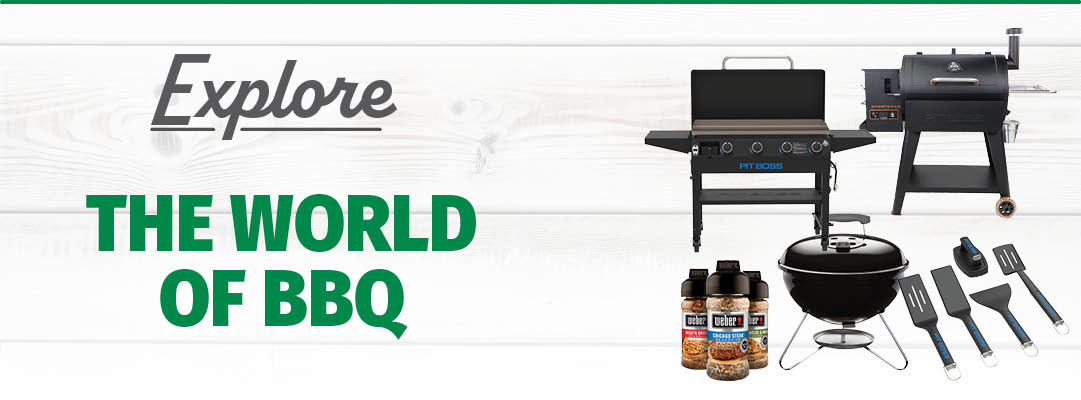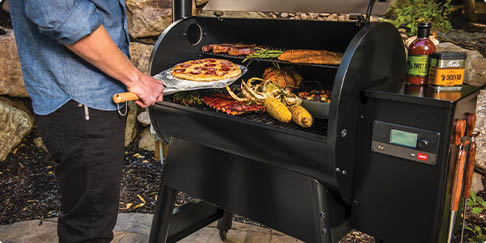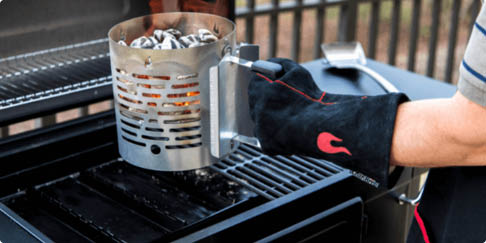Explore the World of BBQ

When it comes to outdoor cooking, three methods stand out as kings of the flame: grilling, smoking, and BBQ. While they all involve the magical dance of fire and food, each technique brings its own unique flavors, aromas, and experiences to the table. In this blog, we'll explore the delightful differences between grilling, smoking, and BBQ, and the tools of the trade. We will also discuss the top 5 foods for outdoor cooking.
- The 3 Main Methods
Grilling is perhaps the most familiar and versatile of the three cooking methods, loved for its simplicity and speed. In grilling, food is cooked directly over high heat – typically from gas, charcoal, or wood – resulting in quick cooking times and delicious sear marks. Grilling is perfect for cooking smaller cuts of meat, such as steaks, burgers, and chicken breasts, as well as vegetables and seafood. The high heat of the grill creates a caramelized crust on the outside of the food while locking in moisture and flavor.
Charcoal grilling is the oldest and most traditional method of outdoor cooking, dating back centuries to when our ancestors first discovered the power of fire. In this method, charcoal briquettes or lump charcoal are ignited and spread evenly across the bottom of the grill. The intense heat produced by the burning charcoal creates those coveted grill marks and smoky flavors that are synonymous with outdoor cooking. Charcoal grilling requires a bit of patience and skill to master, but the results are well worth the effort – juicy, flavorful meats with a delicious charred crust.
Pellet grilling is a relatively newer innovation in the world of outdoor cooking, but it's quickly gaining popularity among grill enthusiasts for its convenience and versatility. In this method, food is cooked over wood pellets that are fed into a hopper and ignited by an electric heating element. The temperature and smoke level can be controlled electronically, allowing for precise cooking and flavor adjustments. Pellet grills offer the smoky flavor of traditional wood-fired cooking with the convenience of set-it-and-forget-it operation, making them ideal for both novice and experienced grillers alike.
Gas grilling is perhaps the most convenient and user-friendly method of outdoor cooking, thanks to the consistent heat and instant ignition provided by propane or natural gas. In this method, food is cooked over burners fueled by gas, which can be easily adjusted to control the temperature and cooking time. Gas grills heat up quickly and are easy to clean, making them perfect for weeknight dinners and impromptu cookouts. While gas grills may lack the smoky flavor of charcoal or pellet grilling, they make up for it in convenience and versatility.
Smoking is a slow and patient cooking method that involves cooking food over low, indirect heat for an extended period of time. The key to smoking is the use of wood smoke – such as hickory, oak, or mesquite – which imparts a rich, smoky flavor to the food. Smoking is ideal for tougher cuts of meat, such as brisket, pork shoulder, and ribs, which benefit from the long, slow cooking process. The result is tender, juicy meat with a deep, complex flavor that's impossible to replicate with any other cooking method. Smoking can be done in a dedicated smoker or on a traditional grill using a smoking box or foil pouch.
BBQ is more than just a cooking method; it's a cultural phenomenon deeply rooted in regional culinary traditions. Like smoking, BBQ involves cooking food over low, indirect heat for an extended period of time, often using wood smoke to impart flavor. However, BBQ is also about the sauces – tangy, sweet, spicy, or smoky, depending on the region – which is used to baste and flavor the meat throughout the cooking process or rubs which are rubbed directly into the meat before cooking allowing the juices of the meat to mix with it and create a smoky and sweet exterior. BBQ is all about low and slow cooking, resulting in tender, flavorful meat that's as much about the journey as it is about the destination.


Every grill master has their arsenal of tools - tongs, spatulas, brushes, and thermometers - each serving a crucial role in the grilling process. Learning how to wield these tools with precision is key to mastering the craft. Knowing when to flip a burger, how to create perfect grill marks, are when the meat reaches the ideal temperature separates the amateurs from the experts. And while gas grill offer convenience and control, charcoal grills provide an unmatched smoky flavor. Regardless of the equipment, the skill of the grill that ultimately determines the outcome.
-
- A high-quality grill brush is essential for cleaning the grates before and after grilling, ensuring a clean cooking surface and preventing food from sticking.
- Heavy-duty tongs are perfect for flipping meats and vegetables without piercing them, preserving juices and flavors.
- Meat thermometers ensure accurate cooking temperatures for safe and perfectly cooked meats, preventing undercooking and overcooking.
- Grill spatulas are ideal for flipping burgers, fish, and delicate foods with precision and ease, featuring a sturdy and wide surface for support.
- A basting brush is used when applying marinades, sauces, and oils to meats and vegetables, ensuring even glazing and flavor distribution.
- A chimney starter aids in quick and efficient charcoal lighteing, eliminating the need for lighter fluid and producing evenly lite coals for consistent temperatures.
- Protecting your grills and smokers with covers will ensure that they will be kept safe from the elements when not in use, allowing them to have a long useful life.
Along with essential tools you want to make sure you have sauces, spices and seasonings on hand.
- BBQ Sauce is a beloved companion to grilling and smoking for several reasons. Firstly, its rich and complex flavor profile adds depth and dimension to meats, enhancing their natural taste with a balance of sweetness, tanginess, and spices. The sauce helps to caramelize and glaze the exterior of the meat, creating a delicious crust and imparting a visually appealing shine. Additionally, BBQ sauce serves as a versatile medium for adding moisture to meats during the cooking process, preventing them from drying out, particularly important for longer smoking sessions. Beyond its functional benefits, BBQ sauce is also deeply rooted in cultural and regional traditions, with different styles representing the diverse culinary heritage of barbecue across the United States. Whether slathered on ribs, brushed onto chicken, or used as a dipping sauce, BBQ sauce is an indispensable element of the grilling and smoking experience, elevating dishes to new heights of flavor and enjoyment.
- Dry rubs are spice blends used to flavor and season meats before grilling or smoking. Unlike BBQ sauce, which is liquid-based and applied during or after cooking, dry rubs consist of a mixture of dried herbs, spices, salts, sugars, and sometimes even dehydrated vegetables or powders. These rubs are generously applied to the surface of meats, forming a flavorful crust when cooked, while also penetrating the meat to infuse it with aromatic and savory flavors. Dry rubs serve multiple purposes in BBQ cooking, enhancing both the flavor and texture of the meat. Firstly, they add layers of complex taste to the exterior of the meat, creating a contrast between the caramelized, flavorful crust and the tender, juicy interior. Secondly, dry rubs help to create a barrier that locks in moisture during the cooking process, resulting in meats that are succulent and moist. Additionally, dry rubs can also contribute to the formation of a desirable bark—the flavorful, slightly crispy outer layer that develops during smoking. Furthermore, dry rubs provide an opportunity for grill masters to experiment with different flavor combinations and spice levels, allowing for endless creativity and customization in BBQ cooking.
There is a pleather of foods that can be grilled and smoked at home.
- The top BBQ foods are (in no specific order):
- Juicy Burgers: Whether you prefer classic beef patties, veggie burgers, or gourmet creations topped with artisanal cheeses and crispy bacon, burgers are a staple of BBQ menus everywhere.
- Tender Ribs: For meat lovers, ribs are the ultimate BBQ indulgence. Whether you're cooking baby back ribs, St. Louis-style ribs, or beef ribs, the key is low and slow cooking to achieve fall-off-the-bone tenderness. Slathered in a tangy BBQ sauce or seasoned with a flavorful dry rub, ribs are a crowd-pleaser that will have everyone coming back for seconds.
- Smoky Brisket: Brisket is the crown jewel of BBQ, revered for its melt-in-your-mouth texture and rich, smoky flavor. Smoking a brisket low and slow over wood chips or charcoal is a labor of love that yields mouthwatering results. Whether sliced thin for sandwiches or served in hearty chunks, brisket is a BBQ classic that will leave your guests impressed and satisfied.
- BBQ Chicken: There are endless ways to prepare this classic. When it comes to grilling BBQ chicken, the key is to cook it low and slow over indirect heat.
- Grilled Vegetables like corn on the cob, bell peppers, zucchini, eggplant, and portobello mushrooms are bursting with flavor and nutrients. Drizzle with olive oil, sprinkle with herbs, and grill until tender for a colorful and healthy addition to any BBQ spread.
- Steaks: Start with high- quality steaks and grill them to your ideal doneness, checking them with a meat thermometer. Make sure to let it rest before serving.
Grilling and BBQing are delicious verstile cooking methods that bring out the best in a wide vairety of foods. Wether you're firing uop the grill for burgers, steaks or veggies or loading the smoker with your favorite wood for smoked chicken or pork there is something undeiably satisfying about cooking outdoors.

